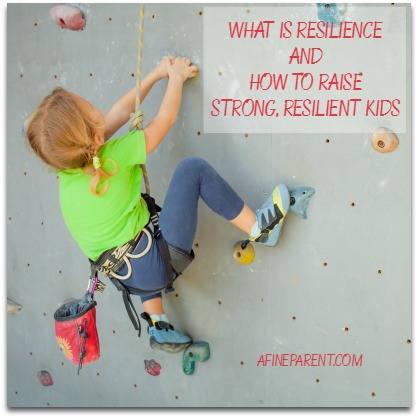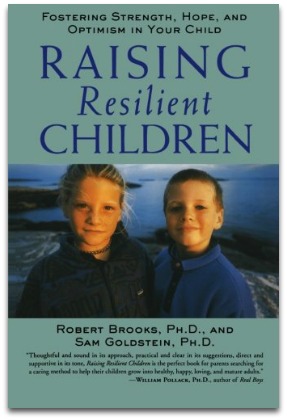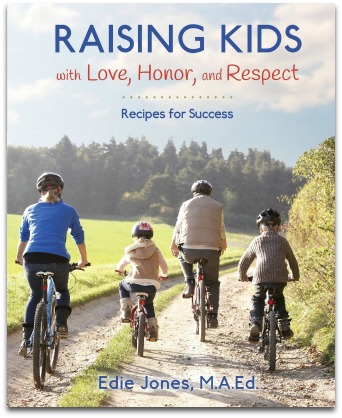 Looking into the face of your newborn is one of the most mesmerizing experiences a parent can have, even when it’s number two, three or four.
Looking into the face of your newborn is one of the most mesmerizing experiences a parent can have, even when it’s number two, three or four.
There’s nothing that surpasses it! Unless it’s watching them walk up to receive their diploma 18 years later.
The fear of every parent when a new baby comes into their lives is that they won’t measure up to the challenge or be able to provide the kind of life that develops kids capable of being strong, competent adults. How well I remember, even though those years were long ago, and I now watch grandchildren move into the adult world.
Looking back and reflecting on qualities that truly make a difference, I feel there are some that stand out as essential. One of those is RESILIENCE – defined in Raising Resilient Children by Robert Brooks and Sam Goldstein as the ability to have inner strength to deal competently and successfully with challenges and demands. It is a quality every parent hopes his or her child develops; however, it is one that doesn’t happen automatically.
A trip down memory lane
As I think back over the years, remembering situations that contributed to who my children are today, I especially recall the time our second daughter was technically “lost” for about 12 hours. She had just turned seven and was near the end of her first-grade year.
My husband had called from another state to let me know that he had found the home he felt we should purchase for our up-and-coming move. He felt it important that I join him by the next day, feeling someone else could buy it if we didn’t act quickly.
In order to make that happen, I had to disperse our four kids to friends. And that I did, distributing them to three loving families that would take good care of them while I was gone. The boys (our two youngest) went to one family, the oldest daughter would be with her best friend and the youngest daughter would be picked up at the bus stop after school to stay with her friend. To expedite getting the girls off to school in the morning, I invited a young couple to stay at our home the first evening I was to be gone. The couples’ job was to get the girls on their way to school while other families would care for them at the end of the day.
Our youngest daughter went to a private school in a city several miles from where we lived. We often shared carpooling with another family for the trip in, with the girls being bussed home at the end of the day. Thinking all was arranged, the couple left our daughter on the front porch of the home of the family she was to ride with to school (this porch was quite a distance from the road in front of the house). Unfortunately, the family was out of town and their daughter was not going to school that day. With that, our seven-year-old remembered well our lesson of, “if you need help or feel lost, stay in one place and someone will come and find you.”
And stay in one place she did, from 7:30 am to about 2 in the afternoon. By then, terribly thirsty, hungry and covered with mosquito bites, she decided to walk out to the end of the driveway and wait on the side of the road. The mailman for our area spotted her, knew she didn’t belong there, knew the family of the home was gone, and convinced her to allow him to take her to the home where her older sister was staying. We have forever prayed thanksgivings and Halleluiahs that he was an honorable person!
So, she was now safe; however, the mom meeting her bus didn’t know that. When our daughter didn’t get off the bus, and a phone call revealed she had not been in school that day, the panic began (of course, unbeknownst to me or my husband as we were deciding on our new home). To make a long story short, the trail of searching eventually lead to the home where she was safely entrenched.
Upon arriving home and hearing all that had happened, this mom couldn’t get to her daughter fast enough – to hug, kiss and wrap her in my arms.
Did I learn valuable lessons? Absolutely.
For peace of mind, at later times when leaving my kids in the care of others, as much as possible, I kept them under one roof. Most importantly, I learned to check and double check details, especially when leaving town.
Did my daughter learn valuable lessons? Again, absolutely!
She learned she could survive on her own, even when very uncomfortable and scared. She learned the importance of following rules while at the same time looking for other alternatives when the rules weren’t working. And she learned not to panic when things didn’t seem right. All of these have helped her become the resilient, competent person she is today.
Would you ever wish a similar experience for one of your children? Of course not.
However, when they do happen, the way you handle the situation will make a huge difference in the value of the lessons learned. I’m not sure I handled it the best way. What I remember was showering her with lots of love and appreciation for how she took care of herself in a very difficult situation.
 In their book Raising Resilient Children, Robert Brooks and Sam Goldstein tell us that it is important for kids to view themselves differently from children who are not successful in meeting challenges and pressures, being able to translate this view into action by being hopeful and possessing a sense of high self-worth.
In their book Raising Resilient Children, Robert Brooks and Sam Goldstein tell us that it is important for kids to view themselves differently from children who are not successful in meeting challenges and pressures, being able to translate this view into action by being hopeful and possessing a sense of high self-worth.
My hope is that I handled our daughter’s experience in a way that left the message that even though she was young, she was a very capable young person, thus contributing to her sense of high self-worth.
The question for parents and grandparents is, how do we help our kids achieve such a state, especially in a world that often throws them curves and obstacles? We’ve all heard about kids who rise above all that life has dealt and marvel at what they end up accomplishing.
Against all odds
An example from the summer Olympics is Ashton Eaton, an American decathlete and two-time Olympic champion, who holds the world record in both the decathlon and indoor heptathlon events and is the second decathlete to break the 9,000-point barrier. Eaton’s parents separated when he was two years old and for much of his life, he was without a father figure until a coach who believed in him came into his life.
His mother, a single mom, worked hard to ensure that her athletic son had the opportunities he needed to succeed. In high school he showed a strong interest in track and field and in 2006 he won the state high school 400m championship and the long jump championship. In spite of that accomplishment, only a few colleges recruited Ashton. With encouragement from his coach, he enrolled in the University of Oregon in 2006 to pursue becoming a Decathlete.
It has been fun to follow the athletic career of this young man, as he was raised in the town in which we live. It’s also been inspiring, knowing his beginnings and the challenges he faced along the way. Looking at him, and the subject of Resilience, it’s valuable to consider some of the things that help kids like Ashton become resilient. I’d like to detail some ideas from Brook and Goldstein’s valuable book below.
#1 Make sure they feel special and appreciated
It’s obvious that Eaton’s mom worked hard at conveying that message. One of the best ways to assure those feelings is to use ENCOURAGEMENT, instead of either praise or criticism. An easy formula to follow is to always be:
- Timely
- Sincere
- Talk of the benefits
- And show appreciation
“Thank you for picking up your toys when you finished playing,” is timely and expresses appreciation. “Now I can walk through the room without stumbling into them,” sincerely describes the benefits to you. “Since you got them picked up so fast, we have time for a quick story,” conveys the benefits for the child.
Encouragement can be used even when things don’t go so well.
“It looks like you forgot to pick up the toys when you finished playing with them (timely). That’s disappointing since I know you can do it (appreciation). When you remember, I don’t have to worry about stumbling over them or stepping on them (benefits). What happens if they get stepped on? (sincere question). That’s right, and we don’t want that to happen, do we? (benefit) Come get me when they’re all put away and if there’s time, we’ll have a quick story (timely/benefit/appreciation).”
#2 Help your kids learn to set realistic goals and expectations
 This is another very important internal resource for developing resiliency. Encouragement, used for both successes (Wow, looks like your hard work really paid off!) and for times that are not successful (I’m sure you’re disappointed. What have you learned and what do you think will make the difference next time?) is one of the ways we can help kids set those goals.
This is another very important internal resource for developing resiliency. Encouragement, used for both successes (Wow, looks like your hard work really paid off!) and for times that are not successful (I’m sure you’re disappointed. What have you learned and what do you think will make the difference next time?) is one of the ways we can help kids set those goals.
Also, learning all we can about developing a Growth Mindset instead of a Fixed Mindset as described by Carol Dweck in her book Mindset: The New Psychology of Success, for both us and our kids, will go a long way in establishing realistic goals. Check back to the previous article published in the Mindset Series of A Fine Parent, How to Prepare Your Kids to Deal with Setbacks and Failures for an in-depth discussion of this important way of thinking.
#3 Help your kids learn to look at mistakes as opportunities
When they make mistakes make sure that instead of treating it as a failure to achieve, they start looking it as learning opportunities. This will also happen when we use the formula of encouragement and keep in mind the development of a Growth Mindset.
#4 Allow your kids to solve their own problems and make decisions
 This adds to resiliency growth in that when it happens our kids know and understand they have influence over what happens to them.
This adds to resiliency growth in that when it happens our kids know and understand they have influence over what happens to them.
As Stephen Glenn shares in Raising Self-Reliant Children in a Self-Indulgent World and his Developing Capable People trainings, one of the important perceptions for all of us is to believe that we can choose how to respond to the things that impact our lives. He also talks about the importance of perceiving that we are capable individuals and that we are important and significant. What a gift we give to our kids when we help them think of themselves in this way!
Every time we give kids the chance to make choices, stay out of their way while solving problems and respect their decisions (this does not mean we need to agree with or allow their decision), we are helping resilience develop. Of course, all of the above needs to be considered with the age and development of each child and adjusted appropriately, starting with the simplest for your youngest and the more complex as they get older.
#5 Help your kids know what they are capable of
When you encourage your kids to do what they can and ask for help when needed, they know for themselves what they can and cannot influence or control. These are important parts of becoming resilient.
When bedtime becomes an issue, point to the clock and ask what time it is. “Yes, it is 8 o’clock, which you know is bedtime. So, time for bed.” sends the message that bedtime is something they cannot control. However, what they wear to bed, or read before going to bed, is something they can influence.
Whether or not a middle school child will be held accountable for required homework is not something they can control. What they can control is choosing to do it right away, after dinner or at 5 in the morning or even whether or not they do it, accepting the results of those efforts.
I’m sure the characteristics mentioned above were part of Ashton Eaton, helping him move forward whenever he had a setback. The encouragement and support from adults, whether parents or others, makes a huge difference in how a child perceives these ideas. As a sideline, the high school coach that saw promise in Ashton back in 2006 was in the grandstands at the Olympics, still encouraging and celebrating the outcome of what it means to be resilient.
Today, when asked if he will go for a third Olympics, Ashton’s answer is “No.” He is ready to move on to use his influence in other ways, such as starting a foundation that will in some way impact the lives of others. That’s the importance of resilience; it provides the glue that creates emotionally strong individuals, the kind every parent dreams of when they look into the eyes of their newborn.
The 2-Minute Action Plan for Fine Parents
Take a few minutes to think about how resilient you are and what helped you gain resiliency.
- When things aren’t going the way you want, are you able to bounce back and find another way to approach the problem?
- How do you model resiliency for your children?
In reflecting on one of your children, what do you consistently do to:
- Make sure they feel special and appreciated?
- Help them learn to set goals?
- Learn from their mistakes?
If you find you are not doing the above, figure out easy steps to begin.
The Ongoing Action Plan for Fine Parents
Considering the age of your children, plan ways you can:
- Allow them to solve their own problems.
- Help them know their capabilities.
- Know what they can and cannot influence.
If you are inclined to journal, keep a log of how the kids are doing and refer back to it and celebrate the successes.
 Want to learn more about helping your kids be resilient and emotionally strong? Order a copy of Edie’s award-winning book, Raising Kids with Love Honor and Respect: Recipes for Success. You can locate it at Amazon, Barnes & Noble, Powell’s and from the author at edie@together-for-children.org.
Want to learn more about helping your kids be resilient and emotionally strong? Order a copy of Edie’s award-winning book, Raising Kids with Love Honor and Respect: Recipes for Success. You can locate it at Amazon, Barnes & Noble, Powell’s and from the author at edie@together-for-children.org.
Have questions or concerns about a problem with a child. Contact edie@together-for-children.org. She’s always available to help.


Very much helpful article 😊
Thank you Eddie for this post. It was a nice and helpful one.
I have discovered that kids should be raised to become responsible adults and most times, what you put in them is what you get.
I will begin to be more intentional about raising strong and resilient kids.
I’d share this article so that more parents would read and learn one or two things.
Nice post. Thank you for publishing
Thank you, I’m glad you liked it and hope it was helpful.
Edie